

Alternator & Battery Info
The Esprits Charging System
The battery and alternator are two of the most important parts of a car. The battery gives the electricity which start and run the entire car, while the alternator produces the electricity which recharges the battery.
Whenever the battery is providing electricity, it is releasing energy of its own through the conversion of reactants into products.
Whenever the battery is getting recharged, it is absorbing energy (provided by the alternator) in order to force the conversion of products back into reactants. Theoretically, this cycle of battery use and recharge can be repeated infinitely, however the process is not 100% efficient. Some of the products and reactants are lost over time, the battery eventually cannot produce enough electricity anymore and you will experience the symptoms of a dying battery.Anything in the car which requires electrical energy will get that energy from the battery, therefore a dying battery will manifest itself through many of these devices malfunctioning. Such devices include but are not limited to:
• starter (engine will turn over slowly or not at all)
• spark plugs (engine will not start or will stall)
• headlights (dim or out)
• indictor lights (blink slowly or not at all)
• heater fan (blows less or not at all)
• wiper motor (wipe slowly or not at all)
• radio (weak or no signal, volume low or off)The alternator uses a belt to siphon some of the engine's power to produce electricity. This process is not unlike the process used in power generation plants in that a powerful magnet is repeatedly turned close to electrical wires. Since an alternator uses moving parts, these are subject to wear and tear. As much as the battery runs the entire car, the alternator keeps the battery fully charged while the engine is operating. A failing alternator will not fully recharge the battery, the battery will drain itself of power rapidly (less than 20 minutes of driving) and you will experience the symptoms of a dying battery.
As stated above, the alternator uses a belt to siphon some of the engine's power in order to produce electricity. Changing the diameter of the pulleys used to drive the alternator will reduce the drag on the engine. The alternator will be turning a little slower ("underdrive"), but manufacturers usually design alternators with up to 25% reserve, meaning you can slow down the alternator by 15% to 20% without affecting the car at all unless you are running more than 600W in accessories (big stereo).
Diagnosing
You can take several easy steps to diagnose whether your alternator is on the fritz. First, most cars today have a dashboard light that glows when the ignition is switched on. This light usually is represented with a symbol of a battery. Have you ever heard a buzzing noise when the key is on, but the car isn't running? That's the voltage from the battery running through the charging system. If this bulb is burned out, chances are the alternator won't work. The car may start, but as we learned, it's just a matter of time before the battery drains and the electrical system fails.
A voltmeter like this could help to figure out if your alternator is on the fritz.As a rule, a three-phase alternator can operate with only one of the stator windings operational, although it's only one-third as efficient. To test whether your car had an issue with one of its stator windings, you'd need to use a voltmeter to check the voltage. (You can buy a basic voltmeter at an electronics store.) This is called a load test. Since the battery produces DC power, set the voltmeter to DC rather than AC. Connect the red lead (or wire) to the positive terminal and the black to the negative. With no accessories on, start the car and raise the RPM to around 1,000. The voltage should register around 14 volts. Anything less than 12 may indicate a problem. Next, turn on the headlights, air conditioner, radio and anything else that draws electrical power. Rev the engine and check the voltmeter. Again, the voltage should register around 14 volts. If you have a failing alternator, the voltage will be well below 14 volts. If so, it's time to replace the alternator.
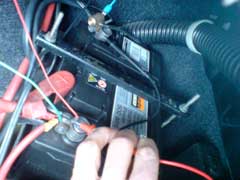
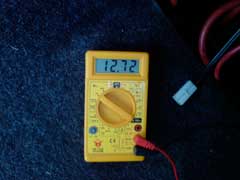
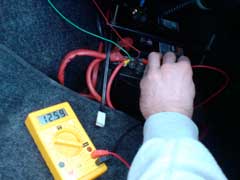
Above is a voltmeter connected to a full charged battery without the engine running, giving between 12-13v.
Before you decide you need to yank the alternator and replace it, make sure you check the belt. If the belt is worn or loose, the alternator won't function properly. A bad belt is easy to replace and won't set you back much.
One thing is certain: A bad alternator will ruin a good battery if you don't address it quickly. Batteries can only be recharged so many times before they'll lose their ability to hold a charge. For the most part, if the battery isn't relatively old, it should survive. But an older battery that is constantly drained and charged, drained and charged will have a shorter life span than a battery operated under normal conditions. The average life span of a battery is usually around 48 months, or a little longer with certain brands.
Esprit Alternator
The Esprit alternator is situated against the firewall at the front of the engine (see above). The alternator isn't anything special on the Esprit and isn't particularly expensive to replace. Best bet is to get a recon'd unit from one of the Esprit independents, like the one below from SWLC.
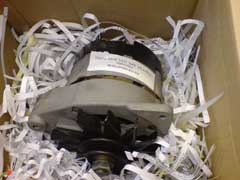
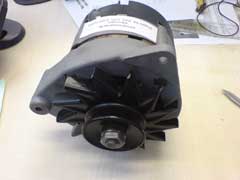
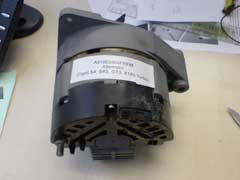
We had a charging issue last year, with the car losing electrical power during it's MOT test and then after being charged, on the journey home. We purchased a new battery, as the previous one was around 4 years old. After running well for a few journeys, we then experienced the same issues. Upon being jump started and running the engine for a short period, the Esprit seemed ok, but obviously had a issue somewhere.
On investigating, we found that the alternator was working intermittently (see above test), which was the source of the problems. We ordered a recon'd unit from SWLC and then looked into replacing it. The Esprit alternator is the same that can be found in any car and only it's location makes it any more difficult than a regular vehicle. On closer inspection of the alternator, we found that during the installation of a new dump valve, one of the pipes had passed over instead of under one of the connections to the alternator and over time had pulled off the connection (see third pic below). On reconnecting this we found the alternator to again be working fully. Whoops!
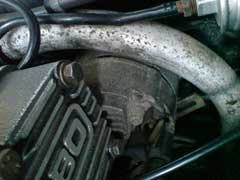
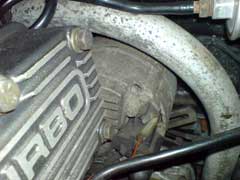
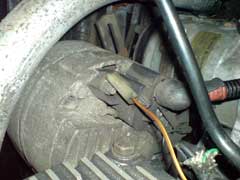
Not wanting for this to happen again and knowing about some of the electrical issues the Esprit can have due to it's fibre-glass bodywork and earthing, we decided to fit a voltmeter to our dash. Voltmeters used to be part of the Esprits dash, but was lost on later models. A voltmeter will give you the reading direct from the battery, so you can tell if it's getting low and will also give you the reading while the alternator is charging it, so you can see if there's any alternator issues at the same time. Perfect.
On looking into voltmeters and finding some nice dual dials (perfect for V8s), we decide to do a retro fit, so not to charge the look too much of our dash (bit late for that really). Main reason was if we started fitting a new dial, we probably wouldn't stop! We managed to get a voltmeter in the same dial style as our current dials from LotusBits.com off an old Lotus Excel. Obviously this isn't useful for every Esprit model and some earlier Esprits already have voltmeters. Later models with need to fit either a dual dial or add an extra one.
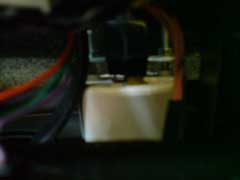
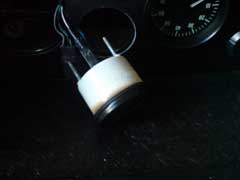
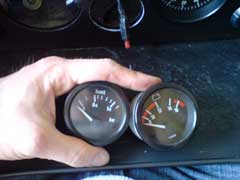
We removed the dash (see here) and unscrewed the boost meter. We will be replacing the boost meter with the voltmeter as we use a turbotimer for our boost reading. This means we won't be losing a dial and don't have the difficult task of adding an extra one.



The voltmeter needs to be attached to the battery, direct to get a true reading. We ran wires from the dash back to the battery following the turbotimer route we has used before. We connected the voltmeter before fitting it to the dash to check it was working properly. We also used the wire for lighting the dial from the boost meter, although it didn't work once everything was put back together. We'll check it next time the dash is off.
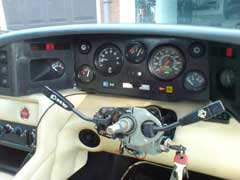

Once everything was put back together we tested the meter again (above left) to make sure if was working and then finished off the install. The meter reads a constant 12v when the engine is off and 14v once it's running. Should be easier to spot a problem now. We also use a trickle charger to keep everything tip-top, so hopefully we'll have a lot less issues with our system in the future. Although we do have a recon'd alternator to fit if we have problems.
LEW's Verdict
This guide isn't the most technical, but will give you some info if you're suffering problems. Using a voltmeter to check your system when you have trouble, will help you find out if it's the battery or alternator. Last thing you want to to charge up the battery and breakdown again a few hours later.
The installation of the voltmeter is just so we can keep an eye on our system. After finding the fault, we check the system, but as the problem was intermittent, we couldn't be 100% sure it was fix. By fitting the meter, we could make sure the alternator was charging the system constantly. It was, so knocking the connection off was the issue we'd caused ourselves. Having the meter there can also help in the future, so hopefully we'll catch any issues before it's too late. At least it gives us a chance.
A common problem now has an Esprit relevant guide to help you out. Job done ;-)
If you have any comments, feel free to e-mail us at admin@lotusespritworld.com
|
|